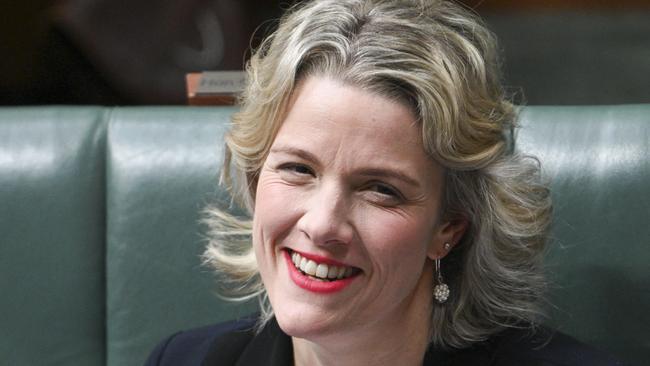High migration a political football but will self-correct: demographer
Record high migration numbers are purely the result of a temporary rise in international students, so cutting permanent targets would be a folly, says leading demographer.

The Albanese government erred by not moving earlier to close down a loophole allowing almost 200,000 international students to “visa hop” to a temporary work visa in 2022-23, which supercharged annual net overseas migration to a record 530,000, the nation’s leading demographer says.
But the Coalition was far from blameless on migration policy, first allowing the temporary skilled migration program to languish during its term in government and then becoming the first opposition party in 80 years not to offer bipartisan support for the permanent migration intake, Peter McDonald said.
In a new paper entitled Understanding Australian Migration 2024, the Emeritus Professor of Demography at the Australian National University argues high net overseas migration numbers since 2022, almost one million, are the result of one-off Covid factors largely likely to self-correct, but both sides of politics are looking for advantage on migration policy ahead of the federal election.
“Both major political parties are targeting arrivals of international students because this is the fastest way to ensure that net overseas migration will fall to a much lower level, an imperative for the government in an election year,” Professor McDonald wrote.
“But there is a definite risk of overshooting and the creation of a roller coaster pattern for NOM (net overseas migration). Unfortunately, in an election context, common sense and careful analysis of the numbers go out the door.”
Professor McDonald said the huge surge in arrivals contributing to NOM for 2022-23 was entirely due to more temporary migrants arriving in Australia, predominantly international students either returning to their course, taking up a spot they couldn’t in 2020 and 2021, or arriving to start a course in 2022.
But departures were also lower because many students “visa hopped” in 2022-23, taking advantage of an earlier change of policy by the government to allow them to obtain a 408 temporary working visa to earn money while campuses were closed in the pandemic. This option remained open post-Covid, and was only recently closed.
“An astounding 192,000 holders of a student or graduate visa hopped to a 408 visa in 2022-23,” Professor McDonald wrote.
“In retrospect, Labor should have terminated access to this visa much earlier than it did. If these visa hoppers in 2022-23 had instead departed Australia, NOM would have been a much more reasonable number.”

But the Coalition had also failed on migration policy by running down the temporary skilled migration scheme, leading to an over-dependence on international students as the source of new skilled immigrants.
And in the current migration debate, fuelled by rising house prices and cost of living, the Coalition was pushing for a cut to permanent migration even though the higher NOM was entirely the result of temporary migration.
“On 16 May 2024 … Peter Dutton became the first federal leader in the 80 years of the post-war migration policy to turn the size of the permanent program into an election issue,” Professor McDonald wrote.
“Dutton called for the level of the permanent program to be reduced from 185,000 as had been specified in the 2024-25 budget to 140,000 to relieve the pressure on housing demand,” he said, noting that 18 months earlier the Opposition leaders had said Labor’s target of 195,000 for the permanent program was too low.
Amid a chronic housing shortage, but facing skills shortages in key areas, migration will remain a key policy issue through to the next election. It is clear public sentiment is against higher migration, and both sides of politics say the current NOM is too high.
The Coalition has hammered migration as an issue, blaming the government for high numbers and claiming they are contributing to both the housing crisis and pressure on major infrastructure.
The government has pledged to halve net overseas migration over the next two years.
Last week home affairs minister Clare O’Neil moved to stop international students “visa hopping” without leaving the country, a move Professor McDonald said was important to stop higher numbers and should also be a requirement for working holiday makers.

But he said most new permanent residents are already on shore, so their impact on the housing market would not be very pronounced, applying to “well under 10,000 migrant families or individuals”.
More broadly, policymakers have consistently failed to distinguish between permanent and temporary migrants despite their demographic differences and access to government services, he warned.
“There are around two million temporary residents in Australia at present. The temporary resident population does not age because it rolls over at the same ages as people arrive and leave.
“Temporary residents also do not have babies while in Australia. They are not eligible for most government services including Medicare, PBS, NDIS, state education, domestic tertiary fees, and many more.
“Temporary residents do not buy houses. While temporary residents are in the housing rental market, they are mainly in dedicated student or backpacker housing, or they live with a higher number of persons per dwelling than the permanent population.
“(But) the difference between permanent and temporary residents is not considered in government planning. It is primarily the permanent population that contributes to economic development and productivity.
“None of this has been considered in the recent debate on Australia’s migration intake,” he said.







To join the conversation, please log in. Don't have an account? Register
Join the conversation, you are commenting as Logout